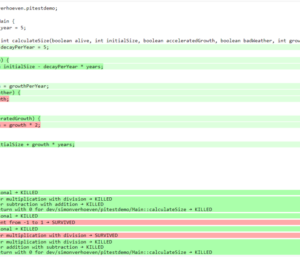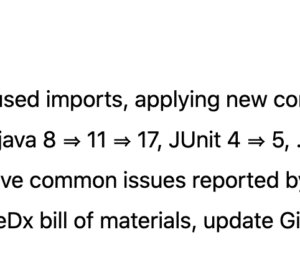ArchUnit: Testing Your Architecture
- September 14, 2023
- 8745 Unique Views
- 8 min read
ArchUnit is a library that allows us to test our architecture (layering/slicing/(naming) conventions, and more).
Why does this matter? It's all about leaving a legacy and safeguarding it. During the lifecycle of a project, people might shift roles, join the team, ... And might not be aware of the conventions within the team/organization.
Testing your architecture is both an aid to ascertain that the architecture is being implemented consistently and also makes it easier for people onboarding to get a grasp of what that agreed architecture is.
One of the advantages of ArchUnit is also that it is "just" another test, and does not need any special infrastructure/new language/... It's just plain old Java (or Kotlin) that can be evaluated with a unit testing tool like JUnit.
Please feel free to clone this repository, so you can easily follow along.
Defining what is analyzed
There are a couple of ways to determine what should be analyzed:
- based upon the class(es)
- by package(s)
- a custom location provider
- using the ClassFileImporter directly on packages/path
Examples can be found in the analysismanagement package
Areas
Core
This contains well, the Core API of ArchUnit which offers us ways to access fields, methods, classes, ... (JavaMethod, JavaField, getMethods(), getRawParametersTypes(), ...)
We can import these using certain provided APIs (see for reference dev.simonverhoeven.archunitdemo.analysismanagement\ClassFileImporterTest.java for some samples albeit there certainly are a lot more options)
As seen you can also add ImportOptions to further narrow what's imported. There are also certain predefined ones such as ImportOption.Predefined.DO_NOT_INCLUDE_JARS.
A sample of a rule to verify that classes under service do not access anything in the controller package:
final var importedClasses = new ClassFileImporter().importPackages("dev.simonverhoeven.archunitdemo.layerviolationmodule");
final var services = importedClasses.stream()
.filter(clazz -> clazz.isAnnotatedWith(Service.class) || clazz.getName().contains(".service."))
.collect(Collectors.toSet());
services.forEach(service -> {
service.getAccessesFromSelf().forEach(access -> {
final var targetName = access.getTargetOwner().getName();
if (targetName.contains(".controller.")) {
final var message = String.format("Service %s accesses Controller %s in line %d",
service.getName(), targetName, access.getLineNumber());
fail(message);
}
});
});
As you can see this is a tad cumbersome, and this is where the higher-level Lang API comes into play
Lang
The lang API offers us some nice functionalities to be more expressive about our architectural concepts.
We can rewrite the Core sample to something pretty similar using:
final var importedClasses = new ClassFileImporter().importPackages("dev.simonverhoeven.archunitdemo.layerviolationmodule");
final var rule = ArchRuleDefinition.noClasses()
.that().resideInAPackage("..service..")
.should().accessClassesThat().resideInAPackage("..controller..");
rule.check(importedClasses);
Library
The library API offers us some nice convenience functions to easily check some common, but complex patterns
- layered architecture
- onion architecture
- slicing
- General coding roles (literally General such as no usage of Joda time, dependency rules, proxy rules)
- using PLANTUML component diagram as rules
Layer checks
Thanks to LayeredArchitecture we can easily define our layers, and verify the way they are accessed.
final var architectureRule = layeredArchitecture()
.consideringAllDependencies()
.layer("Controller").definedBy("..controller..")
.layer("Service").definedBy("..service..")
.layer("Persistence").definedBy("..persistence..")
.whereLayer("Controller").mayNotBeAccessedByAnyLayer()
.whereLayer("Service").mayOnlyBeAccessedByLayers("Controller")
.whereLayer("Persistence").mayOnlyBeAccessedByLayers("Service");
final var importedClasses = new ClassFileImporter().importPackages("dev.simonverhoeven.archunitdemo.layeredmodule");
architectureRule.check(importedClasses);
An example can be found in the LayerTest
Onion architecture
Using OnionArchitecture we define our domain, application services, and adapter and verify whether our classes adhere to these (with optionally some exclusions).
@Test
void onion() {
final var rule = onionArchitecture()
.domainModels("..domain.model..")
.domainServices("..domain.service..")
.applicationServices("..application..")
.adapter("persistence", "..adapter.persistence..")
.adapter("rest", "..adapter.rest..")
.ensureAllClassesAreContainedInArchitecture();
final var importedClasses = new ClassFileImporter().importPackages("dev.simonverhoeven.archunitdemo.onionmodule");
rule.check(importedClasses);
}
An example can be found in the OnionTest which uses the slicingmodule as a verification source. The onion package contains a setup with some violations to demonstrate the validation
Slicing
Using SlicesRuleDefinition we can verify whether our slices are free of cycles/dependencies on each other.
@Test
void noCycles() {
final var rule = slices().matching("dev.simonverhoeven.archunitdemo.slicingmodule.(*)..").should().beFreeOfCycles();
final var importedClasses = new ClassFileImporter().importPackages("dev.simonverhoeven.archunitdemo.slicingmodule");
rule.check(importedClasses);
}
@Test
void noDependencies() {
final var rule = slices().matching("dev.simonverhoeven.archunitdemo.slicingmodule.(*)..").should().notDependOnEachOther();
final var importedClasses = new ClassFileImporter().importPackages("dev.simonverhoeven.archunitdemo.slicingmodule");
rule.check(importedClasses);
}
An example can be found in the SliceTest which uses the slicingmodule as a verification source.
Customization
Custom rules
We can also define our own rules that adhere to the general architectural rule of classes that {PREDICATE} should {CONDITION} by creating our own implementation of DescribedPredicate and ArchCondition respectively in case the predefined rules do not quite fit our needs.
@Test
void controllerCheck() {
var resembleControllerPredicate = new DescribedPredicate<JavaClass>("resemble a controller") {
@Override
public boolean test(JavaClass input) {
return input.isAnnotatedWith(RestController.class) || input.getName().endsWith("Controller") || "controller".equalsIgnoreCase(input.getPackage().getRelativeName());
}
};
var beDefinedAsControllerCondition = new ArchCondition<JavaClass>("should be defined as a controller") {
@Override
public void check(JavaClass input, ConditionEvents conditionEvents) {
if (!(input.isAnnotatedWith(RestController.class) && input.getName().endsWith("Controller") && "controller".equalsIgnoreCase(input.getPackage().getRelativeName()))) {
final var message = String.format("Class %s does not adhere to the controller conditions", input.getName());
conditionEvents.add(SimpleConditionEvent.violated(input, message));
}
}
};
final var importedClasses = new ClassFileImporter().importPackages("dev.simonverhoeven.archunitdemo.custommodule");
final var rule = classes().that(resembleControllerPredicate).should(beDefinedAsControllerCondition);
rule.check(importedClasses);
}
An example can be found in the CustomPredicateAndConditionTest where we define a predicate for what we think a controller looks like, and our condition with the rules we agreed it should adhere to.
Custom concepts
ArchUnit also allows us to control the type of objects that our different concepts (business modules/modules/slices/...) target using AbstractClassesTransformer.
ClassesTransformer<JavaField> constantClassFields = new AbstractClassesTransformer<>("Utility fields") {
@Override
public Iterable<JavaField> doTransform(JavaClasses classes) {
Set<JavaField> fields = new HashSet<>();
for (JavaClass javaClass : classes) {
if (javaClass.getSimpleName().endsWith("Constants")) {
fields.addAll(javaClass.getFields());
}
}
return fields;
}
};
An example can be found in the CustomConceptsTest where we check all our fields in our constants are defined as Static and Final. You can transform to other concepts such as a BookModule for example.
Display format
It is possible to customize the format of the generated messages by creating an implementation of FailureDisplayFormat and configuring it in archunit.properties.
failureDisplayFormat=dev.simonverhoeven.archunitdemo.customization.UppercasingFailureFormat
public class UppercasingFailureFormat implements FailureDisplayFormat {
@Override
public String formatFailure(HasDescription rule, FailureMessages failureMessages, Priority priority) {
String failureDetails = failureMessages.stream()
.map(String::toUpperCase)
.collect(joining(lineSeparator()));
return String.format("ARCHITECTURE VIOLATION [PRIORITY: %s] - RULE '%s' WAS VIOLATED (%s):%n%s",
priority.asString(),
rule.getDescription().toUpperCase(),
failureMessages.getInformationAboutNumberOfViolations(),
failureDetails);
}
}
An example implementation can be found in the UppercasingFailureFormat
Predefined predicates and conditions
Now custom predicates like in the custom predicates and conditions example can often be created using predefined elements which ArchUnit tends to put in an inner Predicates class in the targeted type.
For example: JavaClass.Predicates.assignableTo(//clazz);, and these can also be chained: JavaClass.Predicates.implement("something").and(JavaClass.Predicates.simpleNameEndingWith("something"))
Just like Predicates this is also possible for Conditions, although given their less generic concept they all reside within ArchConditions.
For some properties there are interfaces with Predicates such as HasAnnotations, this can lead to challenges given some predicates thus have the same name.
Keep in mind when chaining that or expects DescribedPredicate
// This Will not work given here .and will expect ? super HasAnnotations final ArchCondition<JavaClass> wrongCondition = ArchConditions.beAnnotatedWith(Controller.class).and(ArchConditions.beEnums()); // This will work since when we apply the enums condition the compiled will see the condition as being for JavaClass ArchCondition<JavaClass> condition = ArchConditions.beAnnotatedWith(RestController.class); condition = condition.and(ArchConditions.notBeEnums());
An example implementation can be found in the PredefinedPredicatesAndConditionsTest
PlantUML
ArchUnit also allows us to import PlantUML diagrams and derive our rules from it to validate our imported JavaClasses.
One has to use component diagrams, where the classes are associated with components through stereotypes.
@startuml [Book] <<..book..>> [Author] <<..author..>> [Reader] <<..reader..>> Author --> Book Reader --> Book @enduml
Which we can then use within our test:
final var diagram = getClass().getClassLoader().getResource("diagram.puml");
classes().should(adhereToPlantUmlDiagram(diagram, consideringOnlyDependenciesInAnyPackage("..plantmodule.."))).check(importedClasses);
An example implementation can be found in the PlantUMLTest
note: There are certain rules to keep in mind for your diagram which you can find in the ArchUnit configuration documentation
Architecture metrics
ArchUnit also allows us to calculate metrics using some well-known software architecture metrics such as:
- Cumulative Dependency Metrics (John Lakos): the basic idea is to calculate the depends on the value
- Component Dependency Metrics (Robert C. Martin): coupling, instability, abstractness, distance from the main sequence
- Visibility metrics (Herbert Dowalil) - relation of visible to hidden elements within a component
@Test
void cumulativeDependencyMetrics() {
final var components = MetricsComponents.fromPackages(packages);
final var metrics = ArchitectureMetrics.lakosMetrics(components);
System.out.println("Cumulative Component Dependency: " + metrics.getCumulativeComponentDependency());
System.out.println("Average Component Dependency: " + metrics.getAverageComponentDependency());
System.out.println("Relative Average Component Dependency: " + metrics.getRelativeAverageComponentDependency());
System.out.println("Normalized Cumulative Component Dependency: " + metrics.getNormalizedCumulativeComponentDependency());
}
@Test
void componentDependencyMetrics() {
final var components = MetricsComponents.fromPackages(packages);
final var metrics = ArchitectureMetrics.componentDependencyMetrics(components);
final var componentIdentifier = "dev.simonverhoeven.archunitdemo.onionmodule";
System.out.println("Efferent Coupling: " + metrics.getEfferentCoupling(componentIdentifier));
System.out.println("Afferent coupling: " + metrics.getAfferentCoupling(componentIdentifier));
System.out.println("Instability: " + metrics.getInstability(componentIdentifier));
System.out.println("Abstractness: " + metrics.getAbstractness(componentIdentifier));
System.out.println("Normalized distance from main sequence: " + metrics.getNormalizedDistanceFromMainSequence(componentIdentifier));
}
@Test
void visibilityMetrics() {
final var components = MetricsComponents.fromPackages(packages);
final var metrics = ArchitectureMetrics.visibilityMetrics(components);
final var componentIdentifier = "dev.simonverhoeven.archunitdemo.onionmodule";
System.out.println("Relative Visibility : " + metrics.getRelativeVisibility(componentIdentifier));
System.out.println("Average Relative Visibility: " + metrics.getAverageRelativeVisibility());
System.out.println("Global Relative Visibility: " + metrics.getGlobalRelativeVisibility());
}
examples can be found in the DependencyMetricsTest
For more information on these metrics, you check out the references at the end of this article.
Resolution behaviour
By default ArchUnit searches for missing classes (a class within the import scope has a reference to a class outside it) on your classpath.
Whilst it is useful for rule evaluation to have information about them (interfaces, annotations, ...) it is also a costly affair performance-wise, and might not always be needed(in case they wouldn't impact the ruleset).
ArchUnit can be configured to create stubs instead which contain some information ( the fully qualified name, methods called, ...) however, some information reliant on the actual class might still be missing (superclasses, annotations, ... i.e. things that need the bytecode of the class).
You can configure this in archunit.properties:
- resolve nothing:
resolveMissingDependenciesFromClassPath=false - partial resolution (everything outside of these 2 packages would be stubbed)
classResolver=com.tngtech.archunit.core.importer.resolvers.SelectedClassResolverFromClasspath classResolver.args=dev.simonverhoeven.imp1,dev.simonverhoeven.imp2
note: It is also possible to implement your own com.tngtech.archunit.core.importer.resolvers.ClassResolver and configure that one.
ArchUnit also allows us to configure the maximum number of resolution iterations for a specific type.
Say we have A => B => C = D. On the first iteration A has B would be resolved, and on the second iteration B has C.
Now we can configure this maximum iteration depth for the 6 different types in archunit.properties, they are:
import.dependencyResolutionProcess.maxIterationsForMemberTypes = 1 import.dependencyResolutionProcess.maxIterationsForAccessesToTypes = 1 import.dependencyResolutionProcess.maxIterationsForSupertypes = -1 import.dependencyResolutionProcess.maxIterationsForEnclosingTypes = -1 import.dependencyResolutionProcess.maxIterationsForAnnotationTypes = -1 import.dependencyResolutionProcess.maxIterationsForGenericSignatureTypes = -1
Where a negative value means full resolution, and 0 disables automatic resolution.
Keep in mind that these should be set to a reasonable default, as the depth can have a performance impact on bigger projects.
Adding ArchUnit to an existing application
In case you want to add ArchUnit to an existing application, you might run into a situation where there are a lot of existing violations, this is where FreezingArchRule comes into play.
FreezingArchRule.freeze(//ArchRule to freeze);This allows you to "accept" the current state of the issues, which will be stored in plain text files by default. In subsequent runs, only new violations will be reported so one can verify that no new ones are being added.
For example, if in this demo project, one were to uncomment dataNew in LegacyService and then run the FreezingValidationTest the test would only complain about the new field since we already acknowledged the existing issue. (see for reference src\test\resources\frozen)
The default configuration is done in src\test\resources\archunit.properties
And there are a couple of different options:
# configure the location of the violation store freeze.store.default.path=src/test/resources/frozen # whether a new store should be created, for a CI build you'll likely want to keep this on the default value of false freeze.store.default.allowStoreCreation=true # whether the stored violations of frozen rules can be updated, the default is true freeze.store.default.allowStoreUpdate=true # whether to allow all violations to be refrozen (i.e. update the store with the current state to mark the current violations as accepted, and report success) freeze.refreeze=false
It is also possible to configure these using system properties
-Darchunit.freeze.store.default.allowStoreCreation=true
There are also 2 extension options for this setup:
- Violation store: you can set up your own implementation of
ViolationStoreand configure ArchUnit to use it - Violation Line Matcher: you can implement your own
ViolationLineMatcherto define how occurred violations should be matched with stored violations.
Furthermore one can also define an archunit_ignore_patterns.txt file in the root of the classpath to ignore violations based upon a regex match.
One can also just tailor their .that() to ignore these legacy classes, but that can quickly become quite cumbersome.
Notes
1)
It is possible to define easy tests using:
@ArchTest private final ArchRule no_field_injection = NO_CLASSES_SHOULD_USE_FIELD_INJECTION;
2)
It is not required to use JUnit, you can also import the core ArchUnit dependency to use it with your testing framework.
3)
Akin to JUnit's @DisplayNameGenerationReplaceUnderscores.class) it is possible to overwrite the output to replace the underscores with spaces to make it a tad more readable.
This is done by creating an archunit.properties file in your test\resources folder with: junit.displayName.replaceUnderscoresBySpaces=true
4)
By default ArchUnit will fail on should() rules being matched against an empty class set.
This is to avoid rules that are accidentally checked against nothing.
This behaviour can be overwritten either on a case-by-case basis
classes().should().beEnums().allowEmptyShould()
Or globally by configuring
archRule.failOnEmptyShould=falsein archunit.properties
ArchUnit caches all classes by location by default, so that they're reused between different test class runs if the same location combination's been imported already.
This has two important implications:
1) garbage collection can lead to a noticeable delay
2) if you know no other test classes will reuse your imports it might be interesting to deactivate the cache.
This cache can be managed by configuring the cacheMode
@AnalyzeClasses(packages = "dev.simonverhoeven", cacheMode = CacheMode.PER_CLASS)5)
It is possible to run ArchUnit rules directly from Maven using the Maven plugin by Société Générale
References
- Cumulative dependency metrics - Large-Scale C++ Software Design by John Lakos
- Component dependency metrics - Clean Architecture by Robert C. Martin
- Visibility metrics - Modular Softwarearchitecture - Herbert Dowalil
Don’t Forget to Share This Post!










Comments (0)
No comments yet. Be the first.